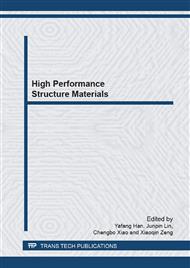p.797
p.804
p.810
p.818
p.823
p.828
p.833
p.839
p.844
Research on Effects of Uneven Macrostructure to Mechanical Properties in TC21 Forging
Abstract:
The microstructure, tensile properties, fracture toughness, fatigue crack growth rate and fatigue limit of different macrostructure regions in TC21 open-die forging were investigated. The results show that the microstructure is also uneven corresponding to non-uniform macrostructure. The ultimate tensile strength (UTS) and yield strength (YS) of coarse-grained zone are that UTS1070MPa, YS960MPa, which can meet the requirement of technical standard, whereas the strength of fine-grained zone drops more than 100MPa. The fracture toughness of this forging is that KIC90MPa·m1/2, being equivalent to the normal one. But when K=11MPa·m1/2, the fatigue crack growth rate is that da/dN=2.488758×10-5mm/cycle, higher than the normal TC21 open-die forging for an order of magnitude. The fatigue limit of fine-grained zone drops about 40MPa compared with coarse-grained zone. Uneven macrostructure and microstructure lead to a decline of tensile and fatigue property in TC21 forging.
Info:
Periodical:
Pages:
823-827
Citation:
Online since:
February 2013
Authors:
Price:
Сopyright:
© 2013 Trans Tech Publications Ltd. All Rights Reserved
Share:
Citation:


